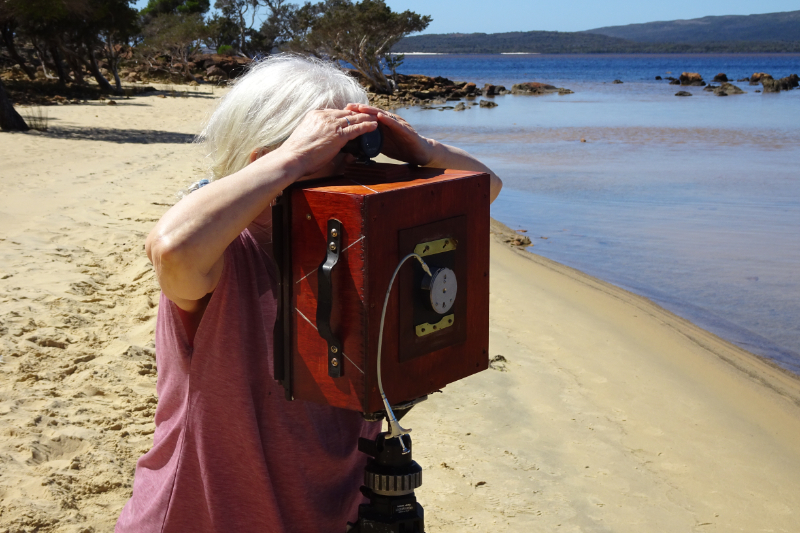Super Wide Woody, Q-SWW home made camera
Oct 31st, 2018 • Tech Notes
Most of my newer work is either 35mm or large format, and medium format camera use has fallen through a hole in the middle. For me medium format always felt like it had the disadvantages of both small and large formats. So I have passed my Hasselblad SWC on to some one who will use it as it deserves
Enter the Super Wide Woody, SWW
A big time ago I bought a 75mm f8 Super Angulon for the Linhof, but wide angle on these cameras is an utter pain in the arse, even with recessed lens panels. I had considered getting a wooden camera to replace the Linhof, but each time I consider this I weigh up all the options and stick with what I know and trust
My first 75mm f8 Super Angulon was in a recessed panel for the Linhof, but this lens, while an optical delight, was in a Compur shutter that was awkward and fiddly to use inside the recess. So I swapped it with a friend for a f5.6 version in a Press Copal shutter, a very easy and sensible shutter in many ways, but it could not be fitted into the recessed panel and work. It works on a flat panel, but the Linhof standard ended up partly off the back of the focusing rail. (For comparison 75mm on 5x4" is equivalent to 38mm on 6x6 and 21mm on 35mm film, so becomes the "standard" super wide angle)
As I wrote, enter the SWW, Super Wide Woodie, a wooden camera box to take a Speed Graphic focusing back on one end and a Goersi helicoid focusing mount on the other with the lens mounted on this. Added to this is a Goersi 72mm view finder on the top. A 72mm VF as that was what was available and all these optical viewfinders have too much "TV Safe" clearance, which means the negative shows far more than the viewfinder does. Even Leica viewfinders have this fault
I took the idea to sculptor and photographer Peter Kovacsy in Pemberton, and very quickly he came up with the camera body shown. Not the design I had envisaged, but very light, with a logical use of materials and a simple elegance



This camera has the advantages of an easy to use International back for view camera screen focusing and composition. This is aided by the very sensible Press Copal shutter which opens the aperture as well as the shutter when the press focus lever is pressed, so is very fast and convienient. Also easy is the viewfinder and scale on the focusing helicoid for fast and simple working. This scale is surprisingly accurate, and will be augmented with a Hyperfocal Distance scale after I have done actual tests resulting in prints. Currently the HfD stuff is on a piece of card
Next post will be pix from it, rather than of it
Update: the Chinese made Gaoersi helicoid was sticking. This was due to one of the two sliders in the mechanism that holds the lens barrel partly rotating in its aluminium groove as it was not even screwed in correctly, so it could swing and jamb against the groove. Also aluminium is the wrong metal for this kind of mechanism and this part should have been faced with steel.
These faults have been cured by totally dismantling the helicoid, cleaning the cheap grease out, inserting the sliders correctly and using very high quality grease. The Gaoersi helicod is basically cheap, which is not helped by poor quality assembly
PS EDIT 2020.06.24
Recently I was preparing drawings for a new 10 x 8" version for 10x8" and for Rae's pinhole work. The lens is a 165mm Angulon on a helicoid mount, interchangable with a pinhole for Rae, and a Kodak 10 x 8" back. Most of the bits were gathered together and almost ready to start, apart from the 10x8" back. However, when this arrived it turned out to be 1/1Pt, so a bit too small. I have been offered a couple of free 5x7" backs which should arrive soon. One of these can become the back for a SWW with 90mm Super Angulon and the other a 5x7" pinhole for Rae's work. The Super Angulon has been raplaced by a 90mm early Angulon lens, which is optically superior for black and white negatives for darkroom printing.
However, I may just make the 5x7" pinhole for Rae and rest with this 5x4" version, as a mere doubling of image area is not that big a deal.
← Return to Blog





 RSS Feed
RSS Feed